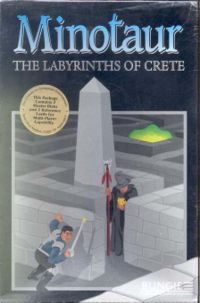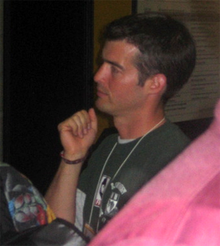
The Marathon Trilogy is a science fiction first-person shooter video game series from Bungie, originally released for the Classic Mac OS. The name of the series is derived from the giant interstellar colony ship that provides the main setting for the first game; the ship is constructed out of the Martian moon Deimos. The series is often regarded as a spiritual predecessor of Bungie's Halo series.

Halo: Combat Evolved is a 2001 first-person shooter video game developed by Bungie and published by Microsoft Game Studios for the Xbox. It was released as a launch game for Microsoft's Xbox video game console on November 15, 2001. The game was ported to Microsoft Windows and Mac OS X in 2003. It was later released as a downloadable Xbox Original for the Xbox 360. Halo is set in the twenty-sixth century, with the player assuming the role of the Master Chief, a cybernetically enhanced supersoldier. The Chief is accompanied by Cortana, an artificial intelligence. Players battle aliens as they attempt to uncover the secrets of the eponymous Halo, a ring-shaped artificial world.

Pathways into Darkness is a first-person shooter adventure video game developed and published by Bungie in 1993, for Macintosh personal computers. Players assume the role of a Special Forces soldier who must stop a powerful, godlike being from awakening and destroying the world. Players solve puzzles and defeat enemies to unlock parts of a pyramid where the god sleeps; the game's ending changes depending on player actions.

Halo 2 is a 2004 first-person shooter game developed by Bungie and published by Microsoft Game Studios for the Xbox console. Halo 2 is the second installment in the Halo franchise and the sequel to 2001's critically acclaimed Halo: Combat Evolved. The game features new weapons, enemies, and vehicles, another player character, and shipped with online multiplayer via Microsoft's Xbox Live service. In Halo 2's story mode, the player assumes the roles of the human Master Chief and alien Arbiter in a 26th-century conflict between the United Nations Space Command, the genocidal Covenant, and later, the parasitic Flood.

343 Guilty Spark, also known as just Spark, is a character in the military science fiction Halo franchise. 343 Guilty Spark plays a major role in the storyline of the original Halo video game trilogy: the character appears in Halo: Combat Evolved, Halo 2, and Halo 3, as well as the remakes of the first two games, Halo: Combat Evolved Anniversary, and Halo 2: Anniversary. 343 Guilty Spark is voiced by actor Tim Dadabo in all media.

Cortana is a fictional artificially intelligent character in the Halo video game series. Voiced by Jen Taylor, she appears in Halo: Combat Evolved and its sequels, Halo 2, Halo 3, Halo 4, Halo 5: Guardians and Halo Infinite. She also briefly appears in the prequel Halo: Reach, as well as in several of the franchise's novels, comics, and merchandise. During gameplay, Cortana provides backstory and tactical information to the player, who often assumes the role of Master Chief Petty Officer John-117. In the story, she is instrumental in preventing the activation of the Halo installations, which would have destroyed all sentient life in the galaxy.

In the Halo universe, an Arbiter is a ceremonial, religious, and political rank bestowed upon Covenant Elites. In the 2004 video game Halo 2, the rank is given to a disgraced commander named Thel 'Vadam as a way to atone for his failures. Although the Arbiter is intended to die serving the Covenant leadership, the High Prophets, he survives his missions and the Prophets' subsequent betrayal of his kind. When he learns that the Prophets' plans would doom all sentient life in the galaxy, the Arbiter allies with the Covenant's enemies (humans) and stops the ringworld Halo from being activated. The Arbiter is a playable character in Halo 2 and its 2007 sequel Halo 3. The character also appears in Halo 5: Guardians and additional expanded universe material. A different Arbiter, Ripa 'Moramee appears in the 2009 real-time strategy game Halo Wars, which takes place 20 years before the events of the main trilogy.
Halo is a military science fiction video game series and media franchise, originally developed and created by Bungie and currently managed and developed by 343 Industries, part of Microsoft's Xbox Game Studios. The series launched in 2001 with the first-person shooter video game Halo: Combat Evolved and its tie-in novel, The Fall of Reach. The latest main game, Halo Infinite, was released in late 2021.

Minotaur: The Labyrinths of Crete is a 1992 role-playing adventure video game for Macintosh by Bungie; produced by Jason Jones and Alex Seropian.
Wideload Games was an American video game developer located in Chicago, Illinois. It was founded in 2003 by Alexander Seropian—the co-founder of Bungie and head behind the games Halo: Combat Evolved, Myth, and Marathon—and six other former Bungie employees three years after Bungie's acquisition by Microsoft Corporation.

Alexander Seropian is an American video game developer, one of the initial founders and later president of Bungie, the developer of the Marathon, Myth, and Halo video game series. Seropian became interested in computer programming in college and teamed up with fellow student Jason Jones to publish Jones's game Minotaur: The Labyrinths of Crete. The two became partners, and Bungie grew to become the best-known Apple Macintosh game developer before being bought by Microsoft in 2001.

Martin O'Donnell is an American composer, audio director, and sound designer known for his work on video game developer Bungie's titles, such as the Myth series, Oni, the Halo series, and Destiny. O'Donnell collaborated with his Michael Salvatori for many of the scores; he has also directed voice talent and sound design for the Halo trilogy.

Marathon is a first-person shooter video game developed and published by Bungie, and released in December 1994 for the Apple Macintosh. The game takes place several centuries into the future in outer space and sets the player as a security officer attempting to stop an alien invasion aboard a colony ship named the Marathon.

The Halo Original Soundtrack is a soundtrack for the video game Halo: Combat Evolved. Composed and produced by Martin O'Donnell and Michael Salvatori for Bungie, the soundtrack was released on June 11, 2002. Most of the music from Halo: Combat Evolved is present on the CD, although some songs have been remixed by O'Donnell in medley form for "more enjoyable" listening. The first piece O'Donnell wrote, known as "Halo", became the basis for Halo's "signature sound" which has been heard in the other games of the main trilogy.

Joseph Staten is an American writer best known for his work at video game studios Bungie, Microsoft Studios, and 343 Industries.

Michael C. Salvatori is an American composer best known for his collaboration with colleague Martin O'Donnell for the soundtracks to the Halo video game series. Salvatori became acquainted with O'Donnell in college; when O'Donnell was given a job offer to score a colleague's film, Salvatori and O'Donnell formed a partnership and eventually created their own production company, TotalAudio. Salvatori continued to manage TotalAudio and worked on his own music for clients such as Disney and Wideload Games.

Luke Michael Smith is an American writer. He was a staff member at the video game development company Bungie, and is a former video games journalist. Smith wrote for a college newspaper and weekly papers in Michigan before being hired as one of the first new freelance writers for Kotaku. At Kotaku, Smith developed his writing style but soon left the site for a staff position as 1Up.com's news editor. Smith made a name for himself at 1Up, particularly through an article he wrote focusing on problems with the game Halo 2.

343 Industries is an American video game developer located in Redmond, Washington, part of Xbox Game Studios. Headed by Pierre Hintze, the studio is responsible for the Halo series of military science fiction games, originally created and produced by Bungie, and is the developer of the Slipspace Engine. Named after the Halo character 343 Guilty Spark, the studio was established in 2007 after the departure of Bungie after the release of Halo 3.
Bungie, Inc. is an American video game company based in Bellevue, Washington, and a subsidiary of Sony Interactive Entertainment. The company was established in May 1991 by Alex Seropian, who later brought in programmer Jason Jones after publishing Jones's game Minotaur: The Labyrinths of Crete. Originally based in Chicago, Illinois, the company concentrated on Macintosh games during its early years and created two successful video game franchises called Marathon and Myth. An offshoot studio, Bungie West, produced Oni, published in 2001 and owned by Take-Two Interactive, which held a 19.9% ownership stake at the time.
















